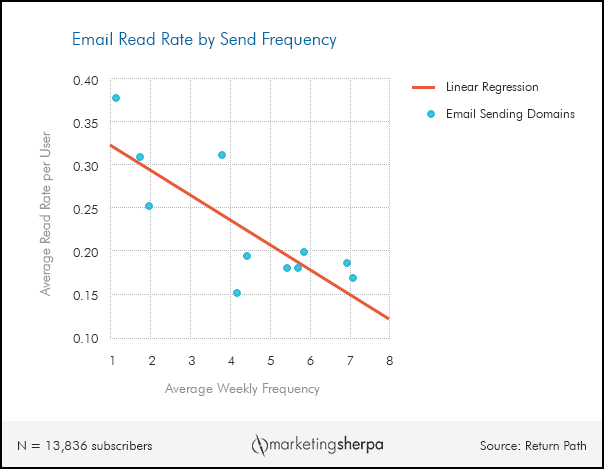by
Dr. Liva LaMontagne , Editorial Research Manager
Between December 2014 and February 2015, Return Path studied email send frequency and engagement among 13,836 email subscribers of eight major apparel retailers.

Click here to see a printable version of this chart
Return Path picked apparel retailers for its analysis because it was looking for a group of businesses that had similar program dynamics, seasonality and customer relationships.
Based on a linear regression analysis (used to determine how send frequency predicted the read rate), the highest read rates could be expected at a once a week send frequency, when customers would read almost every third email (0.32). We reported similar results in our
benchmark study, where 61% of consumers said they would like to receive promotional email "at least weekly."
According to the Return Path study, expected read rates decreased as send frequency increased. However, customers could still be expected to read every fifth email (0.21) at a five times a week send frequency, and every seventh email (0.15) at a seven times a week send frequency.
On the flip side, Return Path also found that customer complaints increased rapidly when email frequency exceeded five messages per week. After exceeding seven messages per week, every tenth customer could be expected to report it as spam to their email providers.
How do you achieve your goal of being on top of your customer’s mind (increase send frequency) without hurting deliverability (decrease spam reports)? We have prepared five tips to help you navigate this issue.
How to find the email frequency that will engage your customers
- Test step-by-step
According to Tom Sather, Senior Director of Research, Return Path, the best course is to increase sending frequency very gradually on specific segments and allow enough time to measure the effect before rolling it out to other segments.
"Even within a group of similar senders, subscriber behavior was unique enough that similar increases were likely to produce different results," Sather said about the current study. "Rigorous testing is critical — what works for one brand is frequently ineffective for another."
- Keep track of customer engagement and disengagement
According to Sather, read rates are the best measure of engagement. However, there are other signals that marketers should look at to monitor their email program’s health.
"Increasing [the] delete-without-reading rate offers an early warning sign that more of your messages are being ignored," Sather said.
- Clean your list
Jill McEwan, Direct Marketing Director, HomeAdvisor, shared her insights from her experience in turning around a large, yet disengaged, list of subscribers.
"We were in the spam folder at major ISPs because we were sending to as many people as possible," McEwan said.
The team started cleaning their list and found thresholds that their top ISPs would tolerate. After that, their list was nearly half the size, but open rates skyrocketed.
"And guess what? We were driving more conversions because we were in the inbox!" McEwan said, adding that "people [who] wanted to receive our email were finally getting it."
If you keep people on your list who don’t engage, you risk ruining it for the people who want to receive your email, concluded McEwan.
- Send engaging emails
McEwan shared that her team made subscriber engagement a goal. They sent out editions such as "Is granite going out of style?" or "Is the dining room dead?" in order to entice opens and clicks.
"If we can keep a subscriber engaged, we can keep them on our list longer," McEwan said. "And hopefully they will convert down the road when they have a home improvement project in mind."
- Let subscribers pick their email frequency
McEwan shared that this approach worked successfully for HomeAdvisor. The team developed an email preference center where people could opt down (from weekly to monthly or quarterly newsletters), and 11% of annual visitors chose to select their email frequency.
To sum up, customer engagement is key to finding the right frequency of communication that won’t overwhelm consumers, but will keep your brand top of mind.
To quote Diana Primeau, Director of Members Services, CBS Interactive, "People always say, ‘How much email is too much?’ As long as people are engaged, that’s the right number."
Related resources
Subscribe to MarketingSherpa Chart of the Week — Get the data and discoveries you need to better serve customers and improve results, delivered straight to your inbox
Email Research Chart: How often customers want to receive promotional emails Email Marketing Research Chart: Why subscribers flag email as spam Case Study: Lands' End improves triggered campaigns to increase email-driven revenue by 9% Email Marketing: Why you should run a win-back campaign (and how CNET engaged 26% of inactives) Learn how to improve your email marketing from the case studies at the
MarketingSherpa Summit 2016 in Las Vegas.
Email Messaging Online Certification Course (From MECLABS Institute, MarketingSherpa's parent research company)









